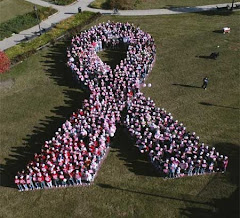As I watch the leaves turn bright autumn colors, I can't believe it's November. This time of year marks a series of milestones for me. Since 2000, it seems that September and October are the biggest months for cancer diagnoses, relapses and other really bad news. In the last year or so I went through a downward spiral involving my original diagnosis, Adenoid Cystic Carcinoma of the Breast (ACCB). A few weeks ago I went to Hopkins for a cryoablation on a growing metastatic lung tumor, which I spoke of in my last post. Cryoablation differs from radiofrequency ablation in that it uses gas to form a ball of ice that freezes the tumor rather than burning it. The procedure went great, but since the pleura is made up of lots of nerve endings, I have varying amounts of pain in my right shoulder, wrapping around to my chest. It's very similar to the pain I still have on my left side from the lung surgery in August 2012, so at least I'm balanced!
Aside from this one tumor, I received unexpected good news in mid July: Somehow, several more tumors in the pleura slowed to a crawl, leaving me with a surprising case of cancer-roller-coaster-whiplash. Now, with the cryoablation out of the way, I have a reprieve from any more medical drama until the next set of scans in mid January.
This luxury allows me to reflect on the biggest milestone of all. November 17th is the third anniversary of my stem cell transplant for Acute Myeloid Leukemia (AML) and the birth of my new immune system (and if my theory is correct, the reason for the recent slow down of ACCB). I remember the Thanksgivings I spent in hospitals, the setbacks, the delays for returning back to work, the life threatening infections and brutal medications. But now that I'm able to experience the beauty of this season as an AML survivor in remission, it seems like a lifetime ago.
Every Saturday, as I speed my way through Maplewood trying to get to the recycle center before it closes, I pass the Fire Department with a sign on the lawn that says, "It's In Their Blood." It's such a great double message; I would always smile to myself and make a mental note to stop there one day to explain why. Today I stopped and rang the front door. It is well documented that many men and women in civil service professions such as firefighters, police officers and the military are donors for stem cell transplants (also referred to as bone marrow transplants since stem cells create bone marrow) through the Be The Match registry. The two men who opened the door were no exception. After thanking them and their fellow firefighters for joining the registry, they said that it's just part of what they do. I said that because what they do is "in their blood," it's now in my blood too, quite literally. Since I have never received a response from the letters I wrote to my donor, it felt good to share a little gratitude with others whose generosity may someday save someone's life.
Since my season of milestones is also the season for giving thanks, I've been thinking about the many things we take for granted and how easy it is to forget to be grateful for the basics. I do it all the time. I'm so happy about the big picture, I often forget about the much smaller picture -- getting one's body to do what it's told to complete the simplest of tasks. I just finished reading an amazing book, which I learned about from Jon Stewart (I never miss The Daily Show on Comedy Central). It's called The Reason I Jump: The Inner Voice of a Thirteen-Year-Old Boy with Autism by Naoki Higashida, published in 2007, translated from Japanese this year. This is one of the most profound books I've ever read. Barely over a hundred pages, this 13 year old boy made me think about every aspect of life in a new way. His pain, love and purity of heart stopped me in my tracks. The book explores a series of questions to help the world understand what it is like to be autistic: "Why do you ask the same questions over and over?" "Why don't you make eye contact when you're talking?" "What is the worst thing about having autism?" and "What's the reason you jump?"

 During this amazing season of nature's transitions, one question seemed especially relevant: "Why do you enjoy going out for walks so much?"
During this amazing season of nature's transitions, one question seemed especially relevant: "Why do you enjoy going out for walks so much?"When we look at nature, we receive a sort of permission to be alive in this world, and our entire bodies get recharged. However often we're ignored and pushed away by other people, nature will always give us a good big hug, here inside our hearts.I don't have any kids. I don't even know anyone with an autistic child. But I don't have to in order to appreciate the magnitude of this boy's challenges and wisdom. As we move through this time of gratitude and Thanksgiving, let's all celebrate the milestones and give each other a good big hug.
Kathy
CANcer + HEALth = CAN HEAL




.bmp)